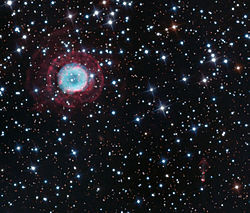| Reflection nebula | |
|---|---|
| Protoplanetary nebula | |
 The Calabash Nebula, as taken by Hubble Space Telescope | |
| Observation data: J2000 epoch | |
| Right ascension | 07h 42m 16.83s [1] |
| Declination | −14° 42′ 52.1″ [1] |
| Distance | 4,200 [2] ly (1,300 pc) |
| Apparent magnitude (V) | 9.47 [1] |
| Apparent dimensions (V) | 10 × 60 arcsec [3] |
| Constellation | Puppis |
| Physical characteristics | |
| Radius | 0.7 [a] ly |
| Absolute magnitude (V) | -1.4 [b] |
| Designations | OH 231.84 +4.22, [1] Rotten Egg Nebula [1] |
| Characteristics | |
|---|---|
| Evolutionary stage | OH/IR star [1] |
| Spectral type | M10III + A [1] |
| Variable type | Mira [1] |
| Database references | |
| SIMBAD | data |
The Calabash Nebula, also known as the Rotten Egg Nebula or by its technical name OH 231.84 +4.22, is a protoplanetary nebula (PPN) 1.4 light years (13 Pm) long and located some 5,000 light years (47 Em) from Earth in the constellation Puppis. The name "Calabash Nebula" was first proposed in 1989 in an early paper on its expected nebular dynamics, based on the nebula's appearance. [5] The Calabash is almost certainly a member of the open cluster Messier 46, as it has the same distance, radial velocity, and proper motion. [6] The central star is QX Puppis, a binary composed of a very cool Mira variable and an A-type main-sequence star.

